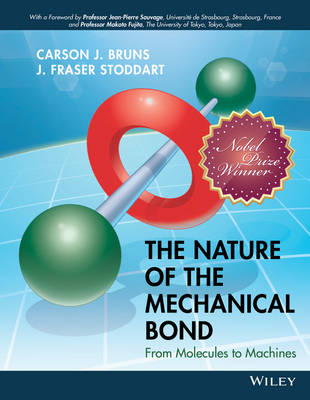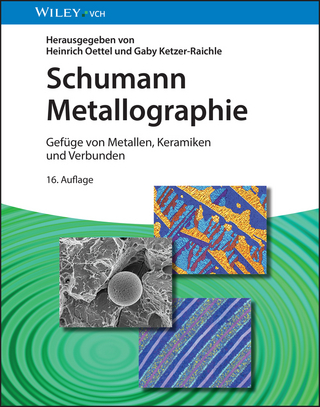
The Nature of the Mechanical Bond
John Wiley & Sons Inc (Verlag)
978-1-119-04400-0 (ISBN)
- Titel z.Zt. nicht lieferbar
- Versandkostenfrei
- Auch auf Rechnung
- Artikel merken
"The story is told by THE inventor-pioneer-master in the field and is accompanied by amazing illustrations... [it] will become an absolute reference and a best seller in chemistry!"
—Alberto Credi
"... the great opus on the mechanical bond. A most impressive undertaking!"
— Jean-Marie Lehn
Congratulations to co-author J. Fraser Stoddart, a 2016 Nobel Laureate in Chemistry.
In molecules, the mechanical bond is not shared between atoms—it is a bond that arises when molecular entities become entangled in space. Just as supermolecules are held together by supramolecular interactions, mechanomolecules, such as catenanes and rotaxanes, are maintained by mechanical bonds. This emergent bond endows mechanomolecules with a whole suite of novel properties relating to both form and function. They hold unlimited promise for countless applications, ranging from their presence in molecular devices and electronics to their involvement in remarkably advanced functional materials. The Nature of the Mechanical Bond is a comprehensive review of much of the contemporary literature on the mechanical bond, accessible to newcomers and veterans alike. Topics covered include:
Supramolecular, covalent, and statistical approaches to the formation of entanglements that underpin mechanical bonds in molecules and macromolecules
Kinetically and thermodynamically controlled strategies for synthesizing mechanomolecules
Chemical topology, molecular architectures, polymers, crystals, and materials with mechanical bonds
The stereochemistry of the mechanical bond (mechanostereochemistry), including the novel types of dynamic and static isomerism and chirality that emerge in mechanomolecules
Artificial molecular switches and machines based on the large-amplitude translational and rotational motions expressed by suitably designed catenanes and rotaxanes.
This contemporary and highly interdisciplinary field is summarized in a visually appealing, image-driven format, with more than 800 illustrations covering both fundamental and applied research. The Nature of the Mechanical Bond is a must-read for everyone, from students to experienced researchers, with an interest in chemistry’s latest and most non-canonical bond.
Carson J. Bruns is a Miller Research Fellow in the College of Chemistry at the University of California, Berkeley. He attended Luther College (2004–2008) where he earned degrees in chemistry, religion, and mathematics. He received a PhD in organic chemistry from Northwestern University (2008–2013), where he was a National Science Foundation (NSF) Graduate Research Fellow. Researching in the United States, Thailand, Korea, and Japan, he has co-authored more than 30 publications which have collectively been cited more than 1000 times. His research interests span all aspects of the mechanical bond, from fundamental science to applied chemical technologies. J. Fraser Stoddart is a Board of Trustees Professor of Chemistry at Northwestern University. By playing a major role in introducing the mechanical bond into molecules, he is one of the few contemporary chemists to have contributed to the opening up of an entirely new field of chemistry. He has pioneered the development of bistable mechanically interlocked molecules (MIMs) for use in molecular electronic devices and drug delivery vehicles. In 2016 he shared the Nobel Prize in Chemistry with Jean-Pierre Sauvage and Ben Feringa for the design and synthesis of molecular machines.
Foreword ix
Preface xi
Acknowledgments xiii
About the Authors xiv
Abbreviations, Acronyms, and Symbols xv
Part 1 Introducing Mechanical Bonds 1
1 An Introduction to the Mechanical Bond 3
Conspectus 3
Introduction 4
1.1 The Ubiquity of the Mechanical Bond 7
1.1.1 Mechanical Bonds in Nature 8
1.1.2 Mechanical Bonds in Art 10
1.1.3 Mechanical Bonds in Everyday Life 11
1.2 Representing Molecular Mechanical Bonds 13
1.2.1 A Historical Perspective 13
1.2.2 Perspective Stereoformulas 16
1.2.3 Depictions in Color 16
1.2.4 Solid-State Portrayals 17
1.2.5 Graphical Representations 18
1.2.6 Technomorphs 20
1.3 Aesthetics of Mechanical Bonds 21
1.3.1 Beauty in Diversity 21
1.3.2 Topological Beauty 21
1.3.3 Architectural Beauty 24
1.3.4 Simplicity and Elegance 28
1.3.5 Complexity and Emergence 30
1.3.6 Beautiful Machines with Mechanical Bonds 32
1.3.7 The Art of the Mechanical Bond 37
1.4 Evolution of Mechanostereochemistry 38
References 42
Part 2 Making Mechanical Bonds 55
2 The Fundamentals of Making Mechanical Bonds 57
Conspectus 57
Introduction 59
2.1 Statistical Synthesis 62
2.2 Directed Synthesis 65
2.2.1 Covalent Templates 65
2.2.2 Covalent-Directed Capture 69
2.2.3 The Möbius Approach 71
2.3 Template-Directed Synthesis 73
2.3.1 Solvophobic Forces 74
2.3.2 Transition Metals Templates 88
2.3.3 π-Donor/π-Acceptor Templates 102
2.3.4 Hydrogen-Bonded Templates 138
2.3.5 Halogen-Bonded Templates 173
2.3.6 Anion-Binding Templates 174
2.3.7 Ion-Pair Templates 191
2.3.8 Other Cationic Templates 195
2.3.9 Macrocyclic Arenes and Heteroarenes 199
2.3.10 Radical-Pair Templates 207
2.3.11 Homophilic Templates 210
2.3.12 Biomolecular Templates 211
2.4 Active Template Synthesis 218
2.4.1 Active Copper Templates 219
2.4.2 Active Zinc Templates 225
2.4.3 Active Palladium Templates 226
2.4.4 Active Nickel Templates 227
Conclusions and Outlook 229
References 230
3 Making Mechanical Bonds Under Thermodynamic Control 269
Conspectus 269
Introduction 271
3.1 Slippage 271
3.1.1 Pseudorotaxane or Rotaxane? 273
3.1.2 Slippage of π-Donor/π-Acceptor Rotaxanes 275
3.1.3 Slippage of Hydrogen-Bonded Rotaxanes 278
3.1.4 Slippage Driven by Hydrophobic Interactions 283
3.1.5 Slippage of Anion-Binding Rotaxanes 284
3.1.6 Triumphs and Tribulations of Slippage 285
3.2 Self-Assembling Metallo-Organic MIMs 285
3.2.1 MIMs Possessing Group 10 Elements 285
3.2.2 MIMs Possessing Group 11 Elements 292
3.2.3 MIMs Possessing Group 12 Elements 297
3.2.4 MIMs Possessing Elements of Groups 7–9 298
3.2.5 MIMs Possessing Alkaline Earth Elements 302
3.3 Mechanical Bond Formation by Condensation 303
3.3.1 Imines 303
3.3.2 Hydrazones 310
3.3.3 Boronic Esters and Boroxines 312
3.4 Mechanical Bond Formation by Olefin Metathesis 313
3.4.1 Ring-Closing Metathesis (RCM) 314
3.4.2 Cross Metathesis (CM) 323
3.5 Mechanical Bond Formation by Reversible Nucleophilic Reactions 324
3.5.1 Disulfide Exchange 324
3.5.2 Reversible Nucleophilic Substitutions 328
3.5.3 Michael Additions 330
3.6 Surface-Mounted MIMs 330
Conclusions and Outlook 333
References 333
Part 3 Cultivating Mechanical Bonds 347
4 Molecular Topologies and Architectures with Mechanical Bonds 349
Conspectus 349
Introduction 351
4.1 Catenane Topologies 352
4.1.1 Prime Links 352
4.1.2 Composite Links 361
4.1.3 Multi-Annulated Catenanes 369
4.1.4 Covalently Bridged Catenanes 386
4.2 Rotaxane Architectures 392
4.2.1 [n]Rotaxanes 392
4.2.2 Dendritic Rotaxanes 416
4.2.3 Covalently Bridged Rotaxanes 424
4.3 Other Architectures with Mechanical Bonds 441
4.3.1 Catenarotaxanes 441
4.3.2 Rotamacrocycles 442
4.3.3 Ring-in-Ring Mechanomolecules 442
4.3.4 Self-Threaded Macropolycyclics 443
4.3.5 Suitanes 444
4.3.6 Foldaxanes 444
4.3.7 Braided and Interwoven Polymer Entanglements 444
Conclusions and Outlook 444
References 445
5 The Stereochemistry of the Mechanical Bond 471
Conspectus 471
Introduction 472
5.1 Dynamic Mechanostereoisomerism 473
5.1.1 Translation and Circumrotation 474
5.1.2 Pirouetting 502
5.1.3 Rocking 512
5.1.4 Robust Dynamics 513
5.2 Static Mechanostereoisomerism 515
5.2.1 Orientational Mechanostereoisomers 515
5.2.2 Sequence Mechanostereoisomers 520
5.2.3 Mechanically Chiral Mechanostereoisomers 522
5.2.4 Topological Stereoisomerism 531
Concluding Remarks 540
References 541
6 Molecular Switches and Machines with Mechanical Bonds 555
Conspectus 555
Introduction 558
6.1 Redox-Driven Switches 560
6.1.1 Redox-Switchable Donor-Acceptor (D-A) MIMs 560
6.1.2 Redox Switching of Metallo-Mechanomolecules 566
6.1.3 Redox Switching of Hydrogen-Bonded MIMs 572
6.1.4 Aqueous Redox Switching 573
6.2 Photo-Driven Switches 574
6.2.1 Switching Driven by Photoinduced Electron Transfer 574
6.2.2 Switching Driven by Photoisomerization 577
6.2.3 Switching in a Dissociative Excited State 580
6.2.4 Switching Driven by Photochemical Reactions 580
6.3 Acid/Base-Driven Switches 581
6.3.1 pH Switching Driven by Hydrophobic Effects 581
6.3.2 pH Switching Driven by Electrostatic Repulsion 583
6.3.3 pH Switching Driven by Hydrogen Bonding 584
6.3.4 pH Switching Driven by Metal Chelation 588
6.4 Cation-Triggered Switches 591
6.4.1 Switching with Transition Metal Cations 591
6.4.2 Switching with Alkali Metal Cations 594
6.4.3 Switching with Alkaline Earth Metal Cations 597
6.5 Anion-Triggered Switches 598
6.5.1 Switches Driven by Anion Solvation Effects 598
6.5.2 Switching Through Second-Sphere Interactions 600
6.5.3 Switches Driven by Anion Binding 600
6.6 Switches Driven by Molecular Recognition 604
6.6.1 Switches Driven by Neutral Small Molecules 604
6.6.2 Switches Driven by DNA Strand Displacement 606
6.7 Switches Driven by Covalent Reactions 607
6.7.1 Switches Driven by Acylations of Amines 607
6.7.2 Switches Driven by Reactions of Pyridines 609
6.7.3 Switches Driven by Protection of Aldehydes 610
6.7.4 Switches Driven by Diels-Alder Reactions 610
6.7.5 Switches Driven by (De)Hydrogenation 610
6.7.6 Switches Driven by the Mitsunobu Reaction 610
6.8 Solvent-Driven Switches 611
6.8.1 Switching Driven by Hydrogen Bond Disruption 612
6.8.2 Switching Driven by Solvation Effects 615
6.9 Thermally Driven Switches 616
6.9.1 Switching Driven by Entropic Effects 616
6.9.2 Switching Driven by Thermal Decomposition 621
6.10 Pressure-Driven Switches 622
6.11 Switches Driven by Electric Fields 623
6.12 Switches Driven by Mechanical Force 624
6.13 Beyond Translation and Circumrotation 627
6.13.1 Expansion and Contraction: Molecular Muscles with Mechanical Bonds 627
6.13.2 Ultramacrocyclic Constriction/Dilation 639
6.13.3 Motions of Branched Rotaxanes 643
6.13.4 The Gemini Co-Conformation 645
6.13.5 Rotaxane Flapping 646
6.13.6 Collapsing Mechanomolecules 647
6.13.7 Mechanically Constrained Inflation/Deflation 647
6.13.8 Folding/Unfolding in Mechanomolecules 647
6.13.9 Stepwise Motion in Pseudocatenanes 649
6.13.10 Molecular Pulleys 649
6.13.11 Multicomponent Pirouetting and Translation 649
6.13.12 Molecular Conveyor Belts 652
6.14 Condensed-Phase Switching 652
6.14.1 Condensed-Phase Redox Switches 652
6.14.2 Condensed-Phase Photoswitches 666
6.14.3 Condensed-Phase Chemical Switches 667
6.15 Mechanomolecular Motors and Machines 669
6.15.1 Systems-Coupled Functional Switches 670
6.15.2 Brownian Ratchets with Mechanical Bonds 694
6.15.3 Mechanically Bonded Molecular Assemblers 706
Conclusions and Outlook 708
References 709
Appendix A: Glossary of Terminology 734
Appendix B: Cover Art Gallery 742
Index 753
| Verlagsort | New York |
|---|---|
| Sprache | englisch |
| Maße | 221 x 282 mm |
| Gewicht | 2359 g |
| Themenwelt | Naturwissenschaften ► Chemie |
| Technik ► Maschinenbau | |
| ISBN-10 | 1-119-04400-6 / 1119044006 |
| ISBN-13 | 978-1-119-04400-0 / 9781119044000 |
| Zustand | Neuware |
| Informationen gemäß Produktsicherheitsverordnung (GPSR) | |
| Haben Sie eine Frage zum Produkt? |
aus dem Bereich


